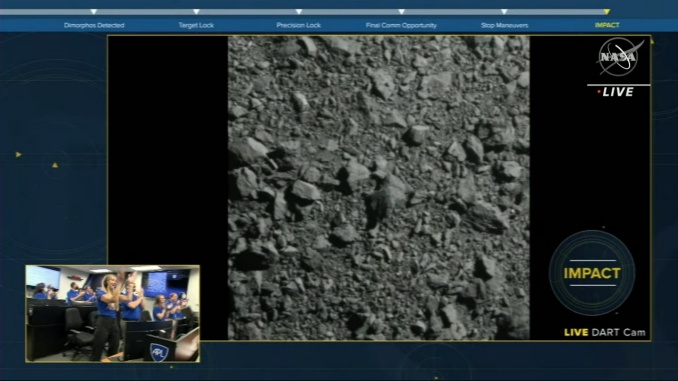On Monday night, cheers erupted within the Johns Hopkins Applied Physics Laboratory at 7:14 pm as NASA’s Double Asteroid Redirection Test, or DART, spacecraft crashed directly into the asteroid moonlet Dimorphos more than seven million miles away from onlookers.
The celebratory moment, captured live by NASA as it lost signal from the DART spacecraft, was the culmination of years of work developing a process for impacting celestial bodies that could threaten life on Earth. According to Johns Hopkins APL director Ralph Semmel, the moment represented a “first demonstration of a game-changing planetary defense capability.”
The idea behind DART is to influence the path and/or orbit of Near-Earth Objects, asteroids or comets within 30 million miles of Earth, whose impact could wipe out millions of lives or even pose an extinction threat for our planet. While Dimorphos wasn’t on course to hit Earth, the relatively close location and size (2,560 feet across) made it a great test case.
The 1,250-pound DART spacecraft launched nearly 10 months ago, made the seven million mile journey to Dimorphos and the asteroid it orbits, Didymos, and slammed into Dimorphos’ rocky surface just 55 miles away from its center. Setting aside the defense ramifications of the operation, the impact stands as a remarkable engineering and astrophysical accomplishment. The precision needed to hit a target that far away with a spacecraft roughly the size of a vending machine is literally otherworldly, especially since the DART team had no command over the spacecraft during the final two minutes before impact.
But the existential implications of DART’s success are what will linger as more study and work is done. Having a defense mechanism against NEOs would take away at least one existential threat to life on Earth without having to resort to unrealistic methods depicted in Michael Bay films, providing a bit of solace even as the planet continues to struggle with the climate change crisis.
This first DART impact was only meant to shift Dimorphos’ orbit around Didymos, with estimates being that it will alter it by 1%. NASA won’t conclusively know just how much the collision shifted the moonlet’s orbit for a couple of months, but the mission’s success validates the process should a NEO be on a crash course with Earth in the future.
“We’re embarking on a new era of humankind, an era in which we potentially have the capability to protect ourselves from something like a dangerous, hazardous asteroid impact,” NASA Planetary Science Division director Lori Glaze told CNN following the mission. “What an amazing thing. We’ve never had that capability before.”
Just to ease the mind, there are no NEOs currently on course to hit the planet and scientists estimate that 95% of all potentially dangerous NEOs have been identified.
And just to prove the unifying nature of this accomplishment, the official Twitter account of SpaceX, whose Falcon 9 rocket launched the DART spacecraft last year, offered congratulations, though with a bit of the trolly tone expected from an Elon Musk-led company. The threatening void of the cosmos can have that effect.
